Science Communication in 20th Century Europe
International Working Group - Berlin Organizer: Prof. Dr. Arne Schirrmacher
Activities:
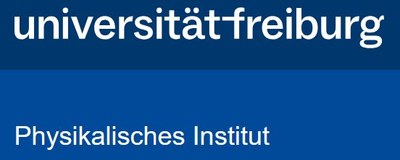 Physics Colloquium, University of Freiburg
Physics Colloquium, University of Freiburg
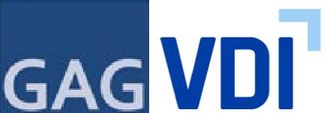 Jahrestagung der Georg-Agricola-Gesellschaft und des Interdisziplinären Gremiums Technikgeschichte VDI e.V.
Jahrestagung der Georg-Agricola-Gesellschaft und des Interdisziplinären Gremiums Technikgeschichte VDI e.V.
 HAPP Seminar, St Cross College Oxford
HAPP Seminar, St Cross College Oxford
From Awe to Experience, from Artefacts to Edufacts? On the Postwar Revolution in the Objects of Science communication
by Arne Schirrmacher
 10th Conference of the European Society for the History of Science
10th Conference of the European Society for the History of Science
Sept. 7-10, 2022, Brussels
-
Symposium:
Designing the Visitor Experience of Postwar Science Display
organized by Arne Schirrmacher and Simona Casonato
contributing: Tim Boon, Christian Sammer, Henry Roberts
Science display in museums, at world’s fairs (like in Brussels 1958), and emerging new institutions such as the science centres have become a venue of growing importance for science policy and the politics of science. Their evolution, however, has brought about a significant transformation: a turn away from the artefact, or historical object, towards the ‘edufact’, or educational object designed to convey a particular – and often politically shaped – scientific insight or phenomenon, rather than documenting the scientific endeavour. The well-lit glass case gave way to set-ups of sensory and immersive experience, while the reach of the scientists and curators shrank and the exhibit designers gained in importance. This shift of actors and agency has not yet found adequate historiographical reflection.
The historiography on world’s fairs and science museums has mostly forgone the role of design and designers for the postwar period; museum history remained unconnected to design history. However, it has occasionally touched upon some exhibit(ion) designers, ranging from somewhat unbeknownst John Anglim (Smithsonian) to the luminaries of Charles and Ray Eames (Mathematica, Seattle World’s Fair). In addition, media history has provided much insight into the politics of media use and immersion for museums without dealing more closely with the postwar period.
To explore the history of the postwar exhibit(ion) design and visitor experience, we ask:
When did designers take over in science museums, and did this relate to new conceptional, medial, or architectural representations of science?
How have new media and immersive exhibits changed science display in museums and at world’s fairs?
How were long-standing museum departments been transformed by a new brand of designers?
How did the shift from the rational and sublime to the sensory and visceral affect the (national) postwar pictures of science?
In this way, existing scholarship about the communication, dissemination and popularization of science from an internationally comparative perspective mostly based on printed media will be extended to the museum medium.
The Public Culture of Science through an Intermedial Lens
Nov 12, 2021, UCL London (virtual)
-
Workshop (for special journal issue)
organized by Tim Boon and Jean-Baptiste Gouyon
contributing: Tim Boon, Bernie Lightman, Scott Curtis, Kirsten Ostherr, Arne Schirrmacher, Rupert Cole, Christian Bonah, Joël Danet, Kristian Nielsen, Kate O’Riordan, Sandra Nelson
The ways in which publics encounter science have been the subjects of various styles of academic and historical enquiry. Most prominently over the last generation we have witnessed the rise of ‘public understanding of science’, which quickly morphed into science communication and public engagement with science. Much of this work is aimed at advocacy of effective technique, rather than being concerned with the disinterested study of science communication as a cultural phenomenon. Elsewhere, scholars have studied the media via which science communication has occurred, whether print publications, performances, films and television or exhibitions and displays. This collection of essays builds on that latter tradition, but with a significant innovation: it invites the reader to appreciate the public culture of science as an entanglement of science within the differing grammars of the media it inhabits. At the level of generalisation, the time-based media of film and television have differing grammars from the spatial grammars of exhibition, the performative techniques of lecturing and the discursive strategies of print. In sum these essays argue and demonstrate that it is only by understanding how science is inflected within these grammars, which themselves have histories that involve the representation of subjects other than science, that we can begin to create a true picture of how science is present in public culture, and with what implications for society.
26th International Congress of History of Science, 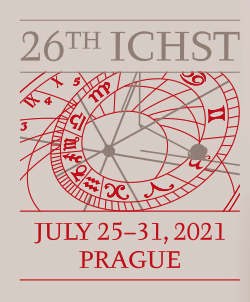 Technology and Medicine
Technology and Medicine
July 25-31, 2021, Prague (virtual)
-
Symposium:
Museum Revolutions? Transformations of Science and Technology Display in Central and Eastern Europe since the 20th Century
organized by Arne Schirrmacher and Jan Surman
contributing: Mirjam Voerkelius, Martin Weiss, Arne Schirrmacher, Ewa Wyka
Science museums and, more recently, science centers have become a global phenomenon. They have been studied historically for national, cultural and economic developments, however, mostly for Europe and North America, where close transatlantic connections between the institutions existed from the outset.
In a first major attempt to delineate the respective museum revolution in Central and Eastern Europe, we consider developments in the 20th and early 21st century. The general frame is set, for example, by starting from Moscow's pre-revolutionary and Prague's pre-WW I museums of technology, over postwar science museums (that were established as in Warsaw or just envisioned and planned as in East-Berlin and Budapest) up to the latest openings of science centers in Warsaw and Pilsen. Within this complex landscape case studies are presented that ask for the reasons for redesigning or reconceptualizing existing museum exhibits, for changes in museum concepts or science display insofar as they reflect broader changes in the interest of society, for national ways of science and technology presentation but also the role of international cooperation, and ultimately, for how museums have shaped the Central and Eastern European "scientific cultures”, i.e. their narratives of progress and their images of science.
In this way, existing scholarship about the communication, dissemination and popularization of science from an internationally comparative perspective mostly based on printed media will be extended to the museum medium.
Von der Kunstkammer zum Futurium. Sammlungen und Ausstellungen von Wissenschaft und Technik in Berlin
Seminar at TU Berlin, SummerTerm 2020
New Book: Architectures of Science
Jovis, Apr. 2020 / Dec. 2019 (German)
Architectures of Science. The Berlin Universities and Their Development in Urban Space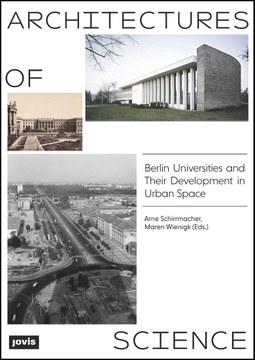
Arne Schirrmacher / Maren Wienigk (eds.)
English, ISBN 978-3-86859-605-2
German, ISBN 978-3-86859-595-6
In Berlin, science, architecture, and the city are interwoven in a unique way: what was originally a single palace in the historic center gradually developed to become a comprehensive academic landscape, in which three large universities today shape the city. Taking a multi perspectival approach, this architectural guide asks how the growth of Berlin as a metropolis has been linked to the development of science and how its various disciplines have been able to realize their demands for buildings to carry out research and teaching and to hold scientific collections. In five chapters, the authors guide readers through various locations in Mitte, Charlottenburg, Dahlem, Adlershof, and Buch and show how questions about the representation and functionality of buildings, their conversion, or even their relocation to the outskirts of the city were reconciled with the expansion of infrastructure and contemporary ideas about urban planning. The book’s critical and detailed look at the architectures of science, the genesis of which it traces over more than two centuries, sheds new light on Berlin’s university landscape.
Workshop
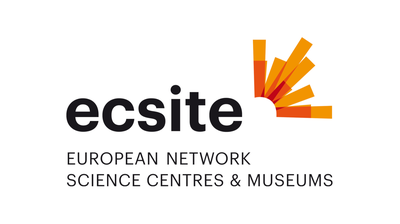 ECSITE Annual Conference
ECSITE Annual Conference
Jun. 6-8, 2019, Copenhagen, Denmark
-
Session:
Fifty Years and Counting: Two Seminal Science Centres Look to the Future-
ECSITE Website
-
Session Leader: Rob Semper, Exploratorium, San Francisco
- Presenters:
-
Arne Schirrmacher, Dept. History of Science, Humboldt University Berlin
Maurice Bitran, CEO and Chief Science Officer Ontario Science Centre, Toronto
Christopher Flink, Executive Director Exploratorium, San Francisco
Gillian Thomas, consultant and President Emerita, Phillip and Patricia Frost Museum of Science, Miami
1969 was a significant year. Neil Armstrong walked on the moon, the hippies came of age, the Beatles performed for the very last time and the Internet was invented. That same year the Ontario Science Centre in Toronto and the Exploratorium in San Francisco opened their doors. A product of the post-sputnik science education fervor and the open education movement of the times, these boundary-pushing organisations served to fuel by example the explosion of non-collections based science centres worldwide.Today, these two organisations have each undergone a significant strategic planning process that builds on their past strengths but points them in new directions for the next 50 years. This session will explore the roots of these institutions at the early history of the science centre movement and discuss their recent visioning process which shows how they have worked to adapt to a changing world.
Museum Film. Development tool and historical source
Seminar at Humboldt University, Winter Term 2018
Exhibition: Architectures of Science
The Universities of Berlin in a European Perspective
Jun. 18 - Jul. 30, 2018, Foyer of the Faculty of Law of the Humboldt Universität zu Berlin, Bebelplatz 2, 10117 Berlin
Nov. 23, 2018 - Jan. 27, 2019, Technische Universität Berlin, Artrium Gallery
Feb. 1 - Mar. 10, 2019, Henry-Ford-Bau der Freien Universität Berlin, Gallery, Garystr. 35, 14195 Berlin-Dahlem
Concept: Gabriele Metzler and Arne Schirrmacher, Department of History, HU Berlin
For about three centuries, buildings of science have shaped the urban face of Berlin. Initially it was the buildings of the Academy of Sciences and the Charité, but from the early 19th century to the present day the universities have had a decisive influence on the appearance of the city. The interweaving of the modern scientific landscape with the development of a European metropolis from enlightened absolutism to the present is condensed in the archetectonic heritage.
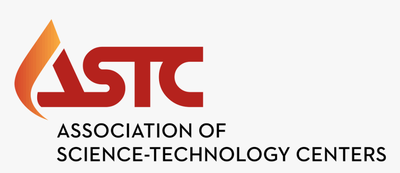 Association of Science and Technology Centers (ASTC) Annual Conference
Association of Science and Technology Centers (ASTC) Annual Conference
Sep. 29 - Oct. 2, 2018, Hartford CT, USA
-
Session:
The Foundations of Interactive Exhibit Design: An Historical Discussion-
ASTC Website
-
Session Leader: Rob Semper, Exploratorium, San Francisco
-
Presenter: Arne Schirrmacher, UC Berkeley & Humboldt University Berlin
-
Interactive exhibits became the signature of science centers that developed in the 60’s. While the design of these exhibits seemed to have developed independently, there is evidence that suggests a common history. This presentation by an historian will examine their history and support a discussion of the nature of interactivity.
Annual Meeting of History of Science Society (HSS)
Nov. 19-22, 2017, Toronto, Canada
-
Session:
On Display: Museums in Twentieth-Century North America-
HSS Website
-
Chair: Bethany G. Anderson, University of Illinois at Urbana-Champaign
-
Married To The Field: Gender, Authority, And Institutional Culture At The Field Museum During The “Heller Affair.” - Matthew Laubacher, Ashford University San Diego
“A Perfect Birthday Present From The American People To Themselves”: Shaping The National Air And Space Museum, 1969-1972 - Jieun Shin, University of Minnesota
North American World's Fairs And The The Re-invention Of The Science Museum In The 1960s - Arne Schirrmacher, Humboldt University, Berlin
Jahrestagung der GWMT
Sept. 22-24, 2017, Münster, Germany
-
Session:
Wozu Wissenschaftsmuseen? Neue Ansätze für die öffentliche Wissenschaftsreflexion,
ca. 1960-2025-
Website
-
Chair: Anke te Heesen, Humboldt-Universität
-
Ohne historische Exponate, aber mit human empowerment: Frank Oppenheimers Exploratorium 1969 - Arne Schirrmacher, HU Berlin
Against the simplicity myth. The 1990s “Empires of Physics” and “1900: The New Age” exhibitions revisited and what we have learned for teaching and historical research - Richard Staley, Cambridge University
Vitrine, Schaufenster, Membran? – Gestaltungs- und Vermittlungskonzepte des Göttinger "Forum Wissen" - Marie Luisa Allemeyer, Universität Göttingen, Zentrale Kustodie
Zwischen Tradition und Transformation: Zur Ausstellungspraxis von Wissenschaft und Technik im "Deutschen Museum 2025" - Ulrich Kernbach, Deutsches Museum München
Mini-Workshop on Science in Film
(in German)
July1, 2016, 2-6 pm, Berlin, Humboldt University, Friedrichstr. 191-193, #5028
"Lehrfilm, Forschungsfilm, Methodenfilm – Formen und Funktionen des frühen Wissenschaftsfilms"
with Anja Sattelmacher, Christian Reiß, Arne Schirrmacher, Anja Laukötter
Display/Politics: From the Transparent Woman to Enola Gay (Key Readings)
Seminar at Humboldt University, Summer Term 2016
Workgroup Brochure
now available
Annual Meeting of History of Science Society (HSS)
Nov. 19-22, 2015, San Francisco, USA
-
Session:
From the Example of the Exploratorium towards a History of
Interactivity
6th International Conference of the European Society for the History of Science (ESHS)
on »Communicating Science, Technology and Medicine«
Sept. 4-6, 2014, Lisbon, Portugal
24th International Congress of History of Science, Technology and Medicine
July 22-28, 2013, Manchester, UK
organized by Arne Schirrmacher and Jean-Baptiste Gouyon
Institut für Geschichtswissenschaften
Exploratory Workshop:
Putting Science on the Air in Europe, 1920s to 1980s
► Topics ► Program ► Summaries
May 3-5, 2012, Luisenstr. 56, 10117 Berlin
Recent Publications
Paper
Das Wissenschaftsmuseum als „politische Maschine“ und seine Transformation im 20. Jahrhundert
in: Acta historica Leopoldina, Nationale Akademie der Wissenschaften, 74 (2019), 107-132.
Contribution
North-American World's Fairs and the Re-Invention of the Science Museum in the 1960s
in: Behind the Exhibit. Displaying Science and Technology at World's Fairs and Museums in the Twentieth Century, ed. by Elena Canadelli, Marco Beretta and Laura Ronzon, Washington: Smithsonian 2018, 158-181.
Thesis
Wissenschaft und Öffentlichkeit im 20. Jahrhundert. Studien zur Genese, Zirkulation und Vermittlung naturwissenschaftlichen Wissens in Deutschland und Europa
Habilitation Thesis, Technische Universität Berlin 2015
Journal issue on
Communicating Science: National Approaches inTwentieth-Century Europe
Science in Context 2013 (with contributions by Paola Govoni, Peter Bowler, Bernadette Bensaude-Vincent, Arne Schirrmacher, James Andrews, Agustí Nieto-Galan) * Introduction
Journal issue on
Popular Science Between News and Education: A European Perspective
Science and Education 2012 (with contributions by E. Mergoupi-Savaidou/F. Papanelopoulou/S: Tzokas, A. Simões/A. Carneiro/M. Diogo, N. Herran, T. Franck, A. Schirrmacher)
Contribution
From Kosmos to Koralle. On the Culture of Science Reading in Imperial and Weimar Germany
in: Quantum Mechanics and Weimar Culture: Revisiting the Forman Thesis, ed. by C. Carson, A. Kojevnikov and H. Trischler, London: Imperial College Press, 2011, 433-452
Preprint
Communicating science in 20th century Europe. A survey on research and comparative perspectives (PDF 12,6 MB) ed. by A. Schirrmacher
Max Planck Insitute for the History of Science, Preprint 385, 2009
Article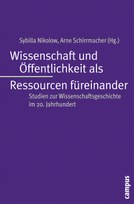
A. Schirrmacher: Nach der Popularisierung. Zur Relation von Wissenschaft und Öffentlichkeit im 20. Jahrhundert (PDF)
in: Geschichte und Gesellschaft 34 (2008), 73-95
Book
Wissenschaft und Öffentlichkeit als Ressourcen füreinander, edited by Sybilla Nikolow and Arne Schirrmacher, Frankfurt: Campus 2007
Workshops and related Conference Symposia
Berlin Workshop 2010, May 6–8, Max Planck Institute for the History of Science
20th Century Science Communication in Europe: The Political and Cultural Context (PDF Flyer)
organized by Arne Schirrmacher
Barcelona ESHS 2010 - Symposium S-39
Representations of Science and Technology in the European Daily Press
organized by Ana Simoes and Faidra Papanelopoulou
Lisbon HoST Workshop 2010
Ciência e Tecnologia para o povo
organized by Tiago Saraiva et al.
Budapest ICHST 2009 - Symposium S-53
Communicating Science in 20th Century Europe: Comparative Perspectives
organized by Arne Schirrmacher and Leszek Zasztowt



